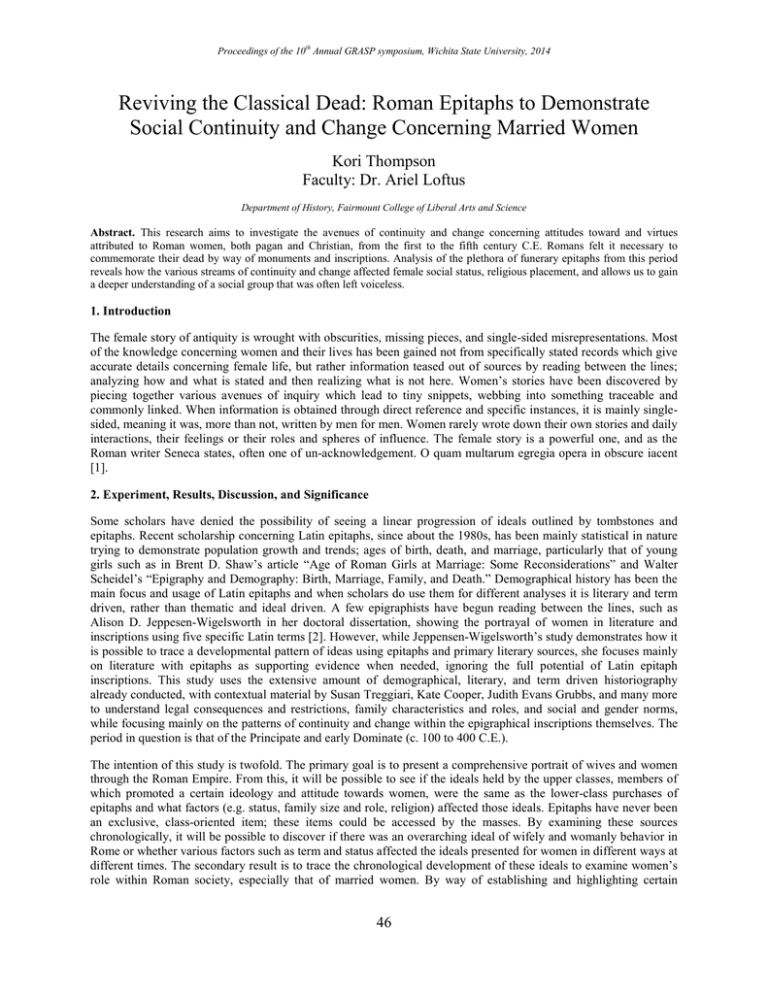Reviving the Classical Dead: Roman Epitaphs to Demonstrate
advertisement

Proceedings of the 10th Annual GRASP symposium, Wichita State University, 2014 Reviving the Classical Dead: Roman Epitaphs to Demonstrate Social Continuity and Change Concerning Married Women Kori Thompson Faculty: Dr. Ariel Loftus Department of History, Fairmount College of Liberal Arts and Science Abstract. This research aims to investigate the avenues of continuity and change concerning attitudes toward and virtues attributed to Roman women, both pagan and Christian, from the first to the fifth century C.E. Romans felt it necessary to commemorate their dead by way of monuments and inscriptions. Analysis of the plethora of funerary epitaphs from this period reveals how the various streams of continuity and change affected female social status, religious placement, and allows us to gain a deeper understanding of a social group that was often left voiceless. 1. Introduction The female story of antiquity is wrought with obscurities, missing pieces, and single-sided misrepresentations. Most of the knowledge concerning women and their lives has been gained not from specifically stated records which give accurate details concerning female life, but rather information teased out of sources by reading between the lines; analyzing how and what is stated and then realizing what is not here. Women’s stories have been discovered by piecing together various avenues of inquiry which lead to tiny snippets, webbing into something traceable and commonly linked. When information is obtained through direct reference and specific instances, it is mainly singlesided, meaning it was, more than not, written by men for men. Women rarely wrote down their own stories and daily interactions, their feelings or their roles and spheres of influence. The female story is a powerful one, and as the Roman writer Seneca states, often one of un-acknowledgement. O quam multarum egregia opera in obscure iacent [1]. 2. Experiment, Results, Discussion, and Significance Some scholars have denied the possibility of seeing a linear progression of ideals outlined by tombstones and epitaphs. Recent scholarship concerning Latin epitaphs, since about the 1980s, has been mainly statistical in nature trying to demonstrate population growth and trends; ages of birth, death, and marriage, particularly that of young girls such as in Brent D. Shaw’s article “Age of Roman Girls at Marriage: Some Reconsiderations” and Walter Scheidel’s “Epigraphy and Demography: Birth, Marriage, Family, and Death.” Demographical history has been the main focus and usage of Latin epitaphs and when scholars do use them for different analyses it is literary and term driven, rather than thematic and ideal driven. A few epigraphists have begun reading between the lines, such as Alison D. Jeppesen-Wigelsworth in her doctoral dissertation, showing the portrayal of women in literature and inscriptions using five specific Latin terms [2]. However, while Jeppensen-Wigelsworth’s study demonstrates how it is possible to trace a developmental pattern of ideas using epitaphs and primary literary sources, she focuses mainly on literature with epitaphs as supporting evidence when needed, ignoring the full potential of Latin epitaph inscriptions. This study uses the extensive amount of demographical, literary, and term driven historiography already conducted, with contextual material by Susan Treggiari, Kate Cooper, Judith Evans Grubbs, and many more to understand legal consequences and restrictions, family characteristics and roles, and social and gender norms, while focusing mainly on the patterns of continuity and change within the epigraphical inscriptions themselves. The period in question is that of the Principate and early Dominate (c. 100 to 400 C.E.). The intention of this study is twofold. The primary goal is to present a comprehensive portrait of wives and women through the Roman Empire. From this, it will be possible to see if the ideals held by the upper classes, members of which promoted a certain ideology and attitude towards women, were the same as the lower-class purchases of epitaphs and what factors (e.g. status, family size and role, religion) affected those ideals. Epitaphs have never been an exclusive, class-oriented item; these items could be accessed by the masses. By examining these sources chronologically, it will be possible to discover if there was an overarching ideal of wifely and womanly behavior in Rome or whether various factors such as term and status affected the ideals presented for women in different ways at different times. The secondary result is to trace the chronological development of these ideals to examine women’s role within Roman society, especially that of married women. By way of establishing and highlighting certain 46 Proceedings of the 10th Annual GRASP symposium, Wichita State University, 2014 virtues, attitudes, and ideas upon female epitaphs, it will be possible to look into the lives and roles of a population normally not granted much of a voice within history. Through the course of the study over two thousand female epitaphs were examined and compared with each other than that of male epitaphs. All inscriptions were examined regardless of the woman’s age if she was married. Key words such as coniunx, uxor, marita, concubina, and contubernalis, along with their conjugations were searched for and helped pinpoint a married woman’s epitaph. All of the key words signify married status and have a specific set of understandings and relationship characteristics. Along with the key words, certain behavioral, characteristics, and personal attributes became prominent. Class distinction and time periods were easily determined based on waves of attribute usage. Religious affiliations in terms of pagan versus Christian could be determined based on the attribute used and how. The results of this study show that the portrayal of a wife depended on her status, time period, burial location (where in Rome or other locations in Italy), and ultimately, the term and personal attributes chosen to categorize her. One such pattern that stuck out was that of bene merenti. The term means “well-deserving” and has had numerous usages through the years, including in military, political, and religious contexts. In the beginning of the period in question, bene merenti strictly used as an attributed reserved for men and free-born women. The freeborn wife was granted this title if her husband and her shared harmony within their marriage. It can be seen as an upmost honor for a female to receive upon her epitaph. However, it was never used upon freedwomen’s epitaphs, regardless of their achievements and personalities. There was an extensive class distinction and is considerable prominent. As the study progressed bene merenti began to change as the prominence of Christianity occurred. Men and women, regardless of station were given the title of bene merenti. For pagan women the attribute was used as a class distinction, but for Christians it was a unification process to demonstrate the inclusiveness of the religion. In the end, this study will add to the wider scholarly discussion on marriage, the place of women, and the interpretations of epitaphs in Rome. It will also inform on issues related to the evolution of symbolism, religious distinctions between pagan and Christian, and transformations within Rome, both on a societal level and within the family structure. By incorporating evidence from legal sources and the contextual atmosphere and comparing them to Latin inscriptions, used in a less traditional manner with statistical analysis, this study will also open epitaphs as a new source of interpretation and available source for students of ancient social history. In the end, more analysis will be paid to epitaphs and their importance in discovering personal, as well as overarching, details of women within Rome in general; find the information that was either thought lost and unrecoverable or even nonexistent from the beginning. 3. Conclusions It is possible to discern social patterns of continuity and change throughout Roman antiquity by examining Latin epitaphs and the various usages of personal attributes to describe women and their lives. While most were written by men, these sources allow the researcher to read between the lines and establish not only women’s roles within the family and greater society, but also the expectations and limitations placed upon them and even their individual stories often left un-acknowledged. 4. Acknowledgements I would like to thank Dr. Ariel Loftus for her guidance and supervision of this project. She first proposed this line of inquiry and helped facilitate my love of Latin epitaphs, while demonstrating how they could be used for something more than just individual commemorations. 5. References [1] Seneca, Consolatio ad Helviam 19.5. [2] Alison D. Jeppesen-Wigelsworth, the Portrayal of Roman Wives in Literature and Inscriptions, (Ph.D. diss., University of Calgary, 2010), 23. 47




